WAMSA: Human and Cultural Dynamics in the West African Middle Stone Age
The WAMSA project, funded under the EU Horizon 2020 programm builds on both previously described work and emerging data from West Africa. Over the last decade, this region is yielding provocative insights that increasingly challenge early narratives about human biological and cultural evolution. Recent introgression of archaic specimens in the modern genome and very long persistence of Middle Stone Age (MSA) technology have been emphasized. The aim is to explain this distinct regional Stone Age Sequence. In other words what are the forces driving forces West African MSA “cultural anachronism”? Are climatic trends sufficient to explain long-lasting behavioral stability? Can demographic conditions between 150 and 11 thousand years ago explain it? Did connections exist between structured populations? Were West African populations geographically separated from the rest of the continent isolated? Were there natural barriers (eg. ecological) separating them from the rest of the continent?
WAMSA PROJECT
WAMSA is the acronym for the research project Human and Cultutral Dynamics in the West African Middle Stone Age. It has received funding from the European Union Horizon 2020 research and innovation program under the Marie Skłodowska-Curie agreement No 101027259.
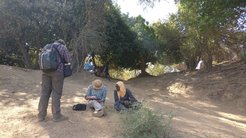
The origin of our species is one of the most hotly disputed topics in paleoanthropology and archaeology. Debates about this issue have typically completely overlooked West Africa. However, the data emerging from this area over the last decade is beginning to challenge early narratives about our evolutionary history. Instead of a single geographical origin, multiple areas seem to have contributed to a long-lasting and complex evolution, with key biological and cultural changes occurring in different places and times. In West Africa, these changes may even have included genetic exchanges between Homo sapiens and late (i.e. ~45ka) “ghost” archaic populations, perhaps underlying the unexpectedly late persistence of archaic morphological traits in Homo sapiens (i.e. ~16-12ka), and a concurrent late persistence of Middle Stone Age technology (i.e. 12ka). Unravelling the patterns of these later biological and cultural trajectories is a key issue for a holistic understanding of the final stages of human evolution prior to the development and homogenizing effects of agriculture. The strong techno-cultural stability characterizing the Late Pleistocene stone tool industries of West Africa raises major questions. Was West Africa isolated from other regions of the continent, thus forming an important reservoir of biological diversity? Or were these unique features of the West African record the result of cultural boundaries, and therefore perhaps among the earliest examples of the defining features of cultural diversity today?
To adequately address these questions, the project will use an interdisciplinary approach which combines results of archaeological investigations with computational models (ecology, demography). MSA lithic assemblages from across West Africa will be described using the concept of “chaîne opératoire” and attributes statistically analyzed. Computational methods will be used to reconstruct the biogeographic conditions and simulate paleodemographic conditions associated with the late Pleistocene in West Africa and surrounding areas. Generated data will be then discussed within current trends in niche construction theory and refugia models. This research principally takes place at the Max Planck Institute of Geoanthropology (Jena, Germany). However, lithic analyses will be carried out at Cheikh Anta Diop University, where most of lithic collections are stored. Dr. Khady Niang is conducting this research as Marie Curie Researcher under the supervision of Prof. Eleanor Scerri, from Max Planck Institute of Geoanthropology.
PRESENTATION OF WEST AFRICA
West Africa is a geographic area including 18 modern political states, stretching between the 17W and 20E meridians. From north to south, it mainly encompasses the area between the 16th and 5th northern parallels, nevertheless northern Mali and Niger respectively reach the 23rd and 24th parallel. The topography of the area is relatively flat, with no major altitudes exceeding 2000m. The region is crossed by two main rivers, the Senegal and the Niger, and a dense network of secondary rivers. The region is divided in three main climatic zones: Sahel, Savanna and Guinea, but vegetation shows variety and complexity. There are at least seven biomes, including Mangrove, Deserts and Xeric Shrublands, tropical and subtropical Grasslands Savana and shrublands, tropical and subtropical dry broadleaf Forest, Tropical and subtropical moist broadleaf forests, flooded grasslands and savannas, montane grasslands and shrublands.
THE MIDDLE STONE AGE
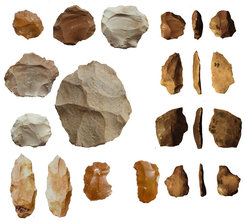
Popularized by Goodwin and Riet Lowe, the expression Middle Stone Age (MSA) was introduced as early as 1927 by Maria William. Typological criteria such “the absence of heavy tools and the predominance of triangular scales with convergent dorsal negatives and faceted platforms” (Goodwin 1929) helped to differentiate this intermediate stage from the Early and the Later Stone Age. This early definition strictly based on typological criteria has been constantly re-evaluated according to new discoveries and theoretical trends. Currently, the MSA is broadly bracketed between 300 and 40 thousand years ago (ka) and its definition associates it with a generalization of prepared core technology (Levallois, discoid, laminar), and the prevalence of toolkits dominated by flakes and retouched flakes. Subsequent, regional trajectories developed across Africa and led to an unprecedent cultural diversity. These techno-cultural changes are broadly contemporaneous with both the emergence of Homo sapiens and a number of technical, symbolic, behavioral innovations including composite tools, the transport of raw material over long distances, the occupation of new ecological niches, the use of ochre, the exploitation of marine resources, the use of personal adornment, engraving, drawing of abstract patterns, etc.
THE MSA IN WEST AFRICA
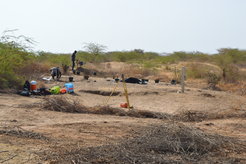
As in the rest of the continent, colonial legacies have profoundly affected the construction of archaeological knowledge in West Africa. A long tradition of surface collection, narrative approaches, and the use of inadequate dating methods hampered the construction of the prehistoric sequence in the area. However, over the last decade, the application of modern techniques to Middle Stone Age (MSA) sites (excavation vs. surface collection), technological and typological descriptions of artefacts (vs. strict typology, use of Optically Stimulated Luminescence or OSL dating method, vs. radiocarbon), and interdisciplinary approaches through the integration of data from paleogenetic and paleoclimatic studies, are progressively shedding light on the crucial role of this region in our evolutionary history.
The transition between the Earlier Stone Age (ESA) and the MSA is poorly understood as the few deeply stratified sequences (Ounjougou in Mali, Anyama in the Ivory Coast) in the region did not yield ESA industries. On the other hand, lithic artefacts bearing MSA features are frequently found across the Sahelian zone of West Africa, but they generally lack stratigraphic context. They have been named after local industrial terms and facies (e.g., Asokrochona Industry, Tiemassassian, Mousteroid, Zenabi, Mai Lumba) and other named technocomplexes (e.g., Aterian) from other parts of the continent. Sometimes the mixture of assemblages from different cultural stages is evident in some MSA industries, such as “Douroumian ensemble”.
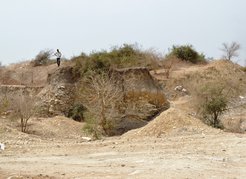
More recent studies emphasized that West African MSA lithic assemblages usually include an important flake component, levallois, discoidal cores and few retouched blanks (mainly scraper, notches and denticulate). Ounjougou is the richest archaeological complex – at least 30 horizons were attributed to the MSA – with chronology dating from Marine Isotope Stage (MIS) 6 (150ka (terminus ante quem)) to MIS 2 (23ka), with high concentrations of finds dating to between 50 ka and 30 ka. The knapping methods (Levallois, discoid, laminar) traditionally associated with the MSA were found at different sites without any apparent evolutionary logic that authors interpret as the result of frequent population changes. At Anymama (Ivory Coast), a 'Sangoan' level is overlain by a classic MSA level. But a controversial thermoluminescence date (because of a large margin error) attributes a terminus post quem of 254 ka to the sequence. At Ravin Blanc I (Falémé valley, Senegal), the MSA industry is associated with elements recalling the Sangoan. At Tomboura (Falémé valley, Senegal), the MSA assemblage displays a strong bifacial component, including points obtained through pressure flaking.
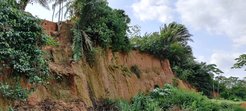
Forested West Africa is less investigated due to logistics. Visibility issues and the “uninhabitability concept” have discouraged serious archaeological investigation of the area. The MSA assemblages from this region are traditionally identified as “Sangoan a technocomplex”, characterized by the presence of heavy-duty picks, choppers, core-scrapers, core-axes, etc. “Lupemban” is another term used to qualify assemblages from this region but it remains very controversial and many authors cast doubt on its existence as cultural entity.




